David Sehrt
-
- NOx Control: Should Certain Vessels Get a Break? Marine News, Dec 2019 #34
When it comes to the EPA’s recent proposed delay to implementation of Tier 4 marine diesel engines ‘in certain high-speed commercial vessels,’ where you stand probably depends on where you sit.
On September 6, the U.S. Environmental Protection agency (EPA) proposed to delay implementation of Tier 4 marine diesel engines “in certain high-speed commercial vessels.” Specifically; EPA mentions three kinds of vessels: lobster boats, pilot boats and a third, more open-ended reference to “other high-speed vessels,” possibly including hovercraft. The proposal is limited to engines with rated power between 600 and 1,400 kW, with one or two engines, and under 65 feet. EPA would also adjust Tier 4 certification requirements.
Under the Hood
EPA’s proposal starts with a distinction between inspected (by the Coast Guard) and uninspected vessels. Inspected vessels include most freighters, workboats and passenger vessels and these are not part of the proposed delay. EPA writes that inspected vessels “operate low in the water and use very large propulsion engines that do not operate at high speeds.” Furthermore, inspected vessels are typically custom-designed and built, which, for EPA, means that “vessel manufacturers can and have been able to accommodate new-tier propulsion and auxiliary engines in new vessels in a timely manner.”Uninspected vessels include recreational vessels, non-industrial fishing vessels, very small cargo vessels (less than 15 gross tons), and miscellaneous vessels such as pilot boats, and law-enforcement vessels. These are likely to be smaller, and operate at higher speeds, compared to inspected vessels. And, these smaller vessels start with a common, fixed design, EPA writes, making it harder to incorporate new engines.
EPA says the delay is warranted because of concerns that suitable Tier 4 engines, with tighter NOx control, are not available for certain vessels with unique demands for speed and power. EPA writes that just one manufacturer has certified Tier 4 engines below 1,400,kW. But there are no Tier 4 engines, EPA asserts further, below 1,400 kW with a power density greater than 35 kW/liter.
The Devil in the Details
Tier 4 phase-in started in 2014, and 2017 was the hammer-date for engines rated from 600 to 1,400 kW. This phase-in was to give boat builders and manufacturers time for redesign and to certify compliance. For boat-builders, Tier 4 engine size and weight present challenges.On the one hand, EPA’s proposed delay is brief. An initial phase would set model year 2022 as the implementation deadline for most engines and installations. Model year 2024 would be a second phase deadline for narrower set of vessels that, EPA believes, “require additional lead time.”
However, delay and phase-in get more complicated because EPA also proposes a waiver system beyond 2024, if Tier 4 challenges continue. EPA also seeks comments on whether it would just make more sense to extend the later phase-in all the way out to 2028.
For example, lobster boats exemplify the Tier 4 engine-vessel challenges. Prior to 2008, the boats stayed relatively close to shore. Now, they travel 40 miles to more distant lobster beds. This requires more cargo space and more speed to complete a day’s work. Older, Tier 3 engines provide that power and speed.
New Tier 4 engines are bigger and new pollution hardware demands even more space. Hence, the EPA logic says that the Tier 4 engines don’t fit in existing hull models. Plus, the additional heat generated by the Tier 4 after treatment is no small thing, something that operators say will require additional space to protect the live lobsters. Basic construction changes are needed but boat manufacturers, according to EPA, can’t progress with substantive redesign until Tier 4s are available and tested. Hence, the proposal to allow more time, to allow new engines to get in synch with vessel demands.
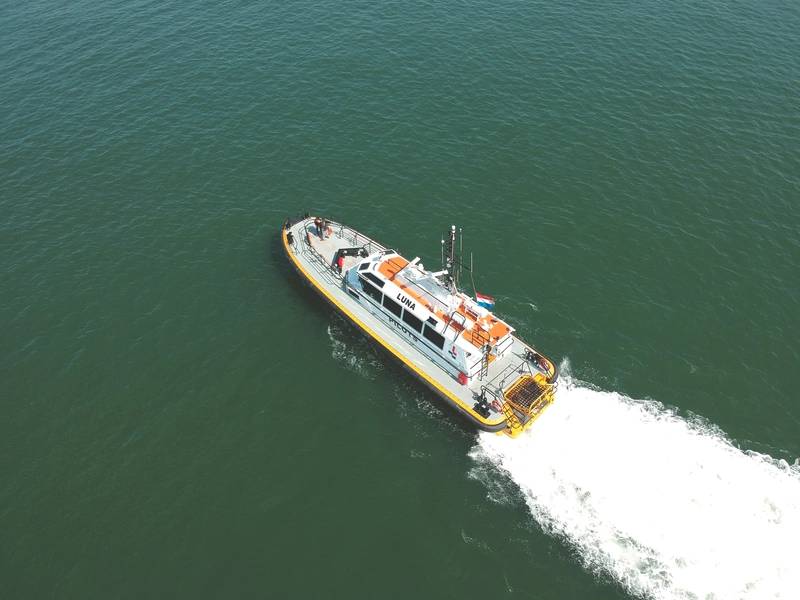 (Credit: MAN)
(Credit: MAN)Industry Weighs In
As is customary with EPA’s rulemaking, the Agency solicited public and industry comments. The deadline in this case was October 21. In addition, EPA held a public hearing on September 20 in Bath, Maine.The Maine Lobstermen’s Association supports EPA’s proposed delay. Patrice McCarron is MLA’s Executive Director. McCarron writes that “the current Tier 4 marine diesel engine emission standard is a mismatch for the Maine lobster fleet.” MLA supports a phase-in through 2024 for certain vessels. If issues remain unsettled MLA wants permission to keep operating Tier 3 engines after 2024.
Separately, many other workboat operators have Tier 4 concerns. Recall EPA’s “inspected” and “uninspected” delineation. That’s arbitrary, assert workboat operators, who insist, ‘we’re facing the same challenges trying to fit throaty power into small workspaces.’ Likewise, Tier 4 has been an issue for American Waterways Operators (AWO) since 2017. A delay was highlighted in a letter to EPA in May 2017: “We are very concerned that, when an AWO member company needs to secure a Tier 4 engine of the correct size and horsepower, there may be none on the market, or the few that are may be very costly.”
Regarding EPA’s current proposal, Jennifer Carpenter, AWO’s executive VP and COO, reiterates these concerns. Carpenter supports EPA’s proposed delay. She writes that towing vessel manufacturers have not been able to accommodate Tier 4 engines and that AWO is not aware of any towing vessel built since 2017, or under construction, with Tier 4 engines less than 1,400 kW (1,877 hp).
At EPA’s Bath hearing, workboat operators emphasized the mixed issues of power, performance and safety. Erwin Thompson, for example, with Houma,LA-based LeBeouf Brothers Towing, conveyed support for EPA’s proposed delay, asking that it include workboats “operating marine diesel engines between 600-1,400 kW (805-1,877 hp).”
Thompson said compliant engines only became commercially available from one manufacturer in 2018, and a second in 2019. He noted initial problems with power loss, with Tier 3 engines on the Mississippi. “When you’re pushing 8,000, 12,000 tons,” Thompson said, “you’re talking about a real critical issue. Northbound on the Mississippi, if you lose an engine, you lose control of your tow.” With Tier 4 adoption, Thompson called for significant testing “before pushing a loaded tank barge full of gasoline, crude oil, or asphalt on our inland waterways.”
David Sehrt, Senior Vice President and Chief Engineering Officer for Ingram Barge Company in Nashville, Tenn., reiterated Thompson’s request for inclusion of inspected vessels, or at least workboats.
At EPA’s hearing, Sehrt described Ingram’s fleeting operations at the intersection of the Ohio and Mississippi Rivers, referring to this locale as a “parking lot” where space is critical for assembling tows. He told EPA that fleeting boats are designed to be as compact as possible, “like the switcher trains in the rail yard.” Maneuverability is paramount, he said. Regarding the larger Tier 4 engines, he continued, “we haven’t done anything as far as being able to figure out how to fit it in the space that we have to operate in.”
Ingram estimates Tier 4 changes will increase the cost of new vessels by $800,000, about three times EPA’s estimated market impact of $255,000. Sehrt focused on another concern. Tier 4s require the use of DEF – diesel exhaust fluid, a urea/water mix sprayed into the exhaust stream to breakdown NOx emissions. Sehrt said that absent demand, DEF isn’t generally available throughout the inland river systems. “A lot of the areas that we operate in are so remote that there is no (DEF) distribution network,” Sehrt said.
 Regarding Tier 4 Engines and SCR & ‘Fleeting boats’: “… we haven’t done anything as far as being able to figure out how to fit it in the space that we have to operate in ... A lot of the areas that we operate in are so remote that there is no (DEF) distribution network.”
Regarding Tier 4 Engines and SCR & ‘Fleeting boats’: “… we haven’t done anything as far as being able to figure out how to fit it in the space that we have to operate in ... A lot of the areas that we operate in are so remote that there is no (DEF) distribution network.”
– David Sehrt, Senior Vice President and Chief Engineering Officer for Ingram Barge CompanyAlso at the Bath hearing, Tj Tarabulski commented on behalf of the Engine Manufacturers Association, which includes 28 international engine companies which manufacture land-based and marine engines. Tarabulski said, in general, EMA agrees with the proposed implementation delay. However, EMA does not support additional extensions of the Tier 4 compliance date or any potential blanket extension to 2028.
Tarabulski noted that manufacturers have already expended significant resources on Tier 4 development. Too much of a delay could result in “stranded Tier 4 investments and disrupted Tier 4 product development plans,” he said, adding that “any last-minute revisions should be targeted and limited.” Regarding a possible waiver program, Tarabulski said EMA is opposed except “perhaps of one additional year on a case-by-case basis.”
Otherwise, EMA wrote in comments sent after the hearing, “the additional waiver process could become the exception that swallows the rule, thereby disrupting manufacturers’ long-planned and significantly-capitalized rollout of the Tier 4 standards.”
Ready or Not
The issue of stranded costs, of pulling the rug out from under responsible corporate investments, is a notion that hits at basic issues of equity and program credibility. After all, EPA’s final Tier 4 rule was published in 2008. Tier 4 deadlines are not a surprise. From EPA’s docket, it appears three companies are making Tier 4 engines now. MAN Truck & Bus SE, Cummins and Caterpillar. All are EMA members.Unlike EMA’s okay for a conditional and limited delay, MAN’s comments to EPA, submitted by Werner Kübler, MAN’s Vice President, Head of Application External Engines, are to the contrary: don’t do it, a delay is not necessary, and it is unfair for businesses that have followed the rules. MAN has Tier 4 engines ready now, Kübler writes. For MAN, the Tier 4 regulations pushed the private sector towards environmentally compliant products. Environmental policy shouldn’t change just because some companies struggled with those goals. MAN calls EPA’s proposal “arbitrary and capricious.”
Kübler writes that “MAN has certified engines available—as of September 3, 2019—in the required power range and power density for the respective marine applications referred to in EPA’s notice.” For EPA’s review, this is new. The September proposal is based on information as of June, 2019.
Kübler disputes the contention that Tier 4 components can’t fit into existing vessel designs. Kübler cites MAN’s development of an “extremely compact solution with a high power-to-weight ratio and significant installation flexibility.” That equipment is already out on the water.
The Dutch Pilot Association, for example, installed two MAN D2862 LE469 engines in their pilot boat Luna in Rotterdam, the first time the selective catalytic reduction (SCR) system was tested at sea. This was for IMO Tier III compliance, due in 2021. The tougher IMO and EPA NOx standards are not apples-to-apples but the important point is that the Luna and these bigger engines perform as expected, even with additional demands for SCR hardware. Top speeds exceed 30 knots. In a press release MAN concedes that while its system is compact, installation was a challenge. “We are learning as we go along,” MAN said.
MAN officials were asked about comments that Tier 4 engines have not been available in the quantities necessary for broad implementation. In other words, does limited supply justify delay?
Florian Schaffelhofer, a MAN press officer, wrote that Tier 4 high-speed engines, and parts as necessary, can be delivered within about 12 weeks, standard timing for MAN. Indeed, some engines are in stock at MAN’s Florida facility. Hence, says MAN, Tier 4 lead times are no different from that experienced for Tier 3 orders.
For its part, and with the comment period now ended, EPA also did not respond to questions about when a decision to delay, or not, will be announced. It is an important issue. The VW settlement money and DERA grants give existing operators plenty of incentive – and much-needed cash – to upgrade legacy power plants. The only question left to answer is what exactly they will do, and why. 2020, therefore, promises to be an interesting year when it comes to workboats and marine propulsion.
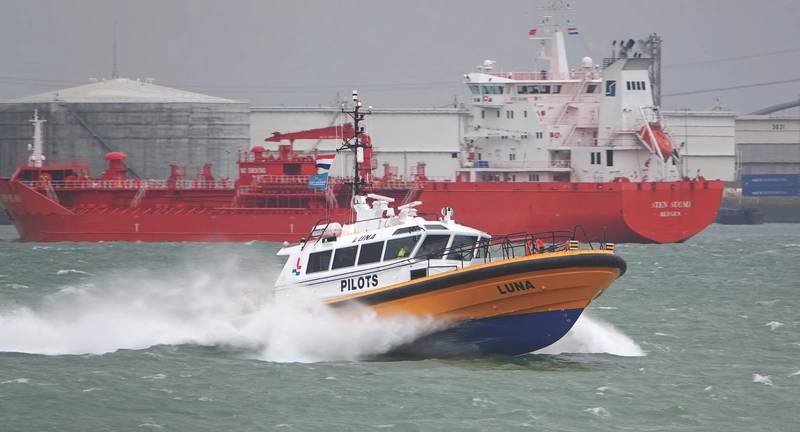 The pilot boat Luna (Port of Rotterdam), with twin MAN turbocharged engines, has a top speed in excess of 30 knots. (Credit: MAN)
The pilot boat Luna (Port of Rotterdam), with twin MAN turbocharged engines, has a top speed in excess of 30 knots. (Credit: MAN) -
- EPA’s SmartWay Initiative Makes Way on the Water Marine News, Mar 2015 #36
one of the largest inland marine transportation companies in the U.S. moving nearly 100 million tons of cargo annually on the nation’s rivers. Ingram’s David Sehrt, Senior Vice President and Chief Operations Officer, explains, “Our long-term commitment to air emissions reduction spans 15 years through a diesel
-
 )
March 2024 - Marine Technology Reporter page: 11
)
March 2024 - Marine Technology Reporter page: 11assist in identifying mines and act as a neutralization device. About the Author Bottom mines pose even greater chal- David R. Strachan is a defense analyst and founder of lenges. Unlike contact mines, bottom Strikepod Systems, a research and strategic advisory mines utilize a range of sensors to
-
 )
March 2024 - Marine Technology Reporter page: 8
)
March 2024 - Marine Technology Reporter page: 8INSIGHTS SUBSEA DEFENSE Copyright RomanenkoAlexey/AdobeStock WHEN THE SHOOTING STOPS: BLACK SEA MINE CLEARANCE WILL FEATURE ADVANCED TECH, CONOPS By David Strachan, Senior Analyst, Strikepod Systems ince the beginning of the war in Ukraine, mine warfare mines have been the weapon of choice for both sides
-
 )
March 2024 - Marine Technology Reporter page: 6
)
March 2024 - Marine Technology Reporter page: 6and Mechatronics at Villanova University and a Master of Engineering in Systems Engineering and Project Management from Cornell University. Strachan David R. Strachan is a defense analyst and founder of Strikepod Systems, a research and strategic advisory focusing on autonomous undersea Lundquist Wigen syste
-
 )
March 2024 - Marine Technology Reporter page: 4
)
March 2024 - Marine Technology Reporter page: 4members sent to speci? c events.. Celia Konowe We have media serving the global maritime, subsea, offshore energy, ports and logistics Edward Lundquist David Strachan markets, which in this context means that we attend a lot of exhibitions and conferences. Since we started attending ‘live’ again in 2022
-
 )
March 2024 - Marine Technology Reporter page: 2
)
March 2024 - Marine Technology Reporter page: 2/ Rebekah Parsons-King 8 Subsea Defense Black Sea Mines When the shooting stops in the Ukraine, the tough work of clearing mines will commence. By David Strachan 12 Gliders Slocum Sentinel 22 Teledyne Marine debuts the Slocum Sentinel Glider. By Shea Quinn 22 Instrumentation Volcano Hunter 28
-
 )
April 2024 - Maritime Reporter and Engineering News page: 48
)
April 2024 - Maritime Reporter and Engineering News page: 48Corporation, 280 Lincoln Street, SONAR TRANSDUCERS Texas 77087 , tel:(713) 644-1183, fax:(713) 644-1185, Hingham, MA 02043-1796 , tel:(781) 749-4800, [email protected] [email protected] Massa Products Corporation, 280 Lincoln Street, Hingham, MA 02043-1796 , tel:(781) 749-4800, INERTIAL SENSING
-
 )
April 2024 - Maritime Reporter and Engineering News page: 32
)
April 2024 - Maritime Reporter and Engineering News page: 32of an ordi- the high-spec construction vessels available at attractive rates, nary crane. “Effectively, it can move the foundation in one lift says David Inman, Sales Manager at NOV-subsidiary GustoM- and then immediately pick up the tower.” SC. “The industry needs assets speci? cally designed for what
-
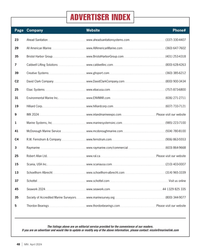 )
April 2024 - Marine News page: 48
)
April 2024 - Marine News page: 48.com (401) 253-4318 7 Caldwell Lifting Solutions www.caldwellinc.com (800) 628-4263 39 Creative Systems www.ghsport.com (360) 385-6212 C2 David Clark Company www.DavidClarkCompany.com (800) 900-3434 25 Ebac Systems www.ebacusa.com (757) 873-6800 31 Environmental Marine Inc. www.ENVMAR
-
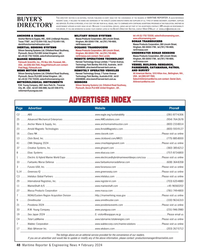 )
February 2024 - Maritime Reporter and Engineering News page: 48
)
February 2024 - Maritime Reporter and Engineering News page: 48Corporation, 280 Lincoln Street, SONAR TRANSDUCERS Texas 77087 , tel:(713) 644-1183, fax:(713) 644-1185, Hingham, MA 02043-1796 , tel:(781) 749-4800, [email protected] [email protected] Massa Products Corporation, 280 Lincoln Street, Hingham, MA 02043-1796 , tel:(781) 749-4800, INERTIAL SENSING
-
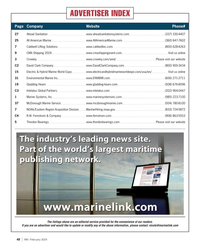 )
February 2024 - Marine News page: 48
)
February 2024 - Marine News page: 48.com (800) 628-4263 9 CMA Shipping 2024 www.cmashippingevent.com Visit us online 3 Crowley www.crowley.com/wind Please visit our website C2 David Clark Company www.DavidClarkCompany.com (800) 900-3434 15 Electric & Hybrid Marine World Expo www.electricandhybridmarineworldexpo.com/usa/en/
-
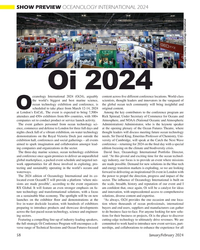 )
January 2024 - Marine Technology Reporter page: 58
)
January 2024 - Marine Technology Reporter page: 58, on-water technology thought leaders will discuss meeting future ocean technology demonstrations on the Royal Victoria Dock just outside the needs. Sir David King, Emeritus Professor of Chemistry, Uni- exhibition hall, conferences and social gatherings – all events versity of Cambridge, will speak at the
-
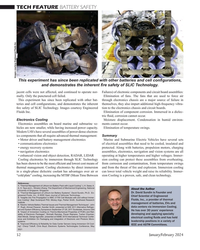 )
January 2024 - Marine Technology Reporter page: 52
)
January 2024 - Marine Technology Reporter page: 52.H. Sawa, A. A. O. Taya and L. Winston Zhang; The Department of Mechanical Engineering, National About the Author University of Singapore, Singapore Dr. David Sundin is Founder and 2. “Thermal Management of Lithium-Ion Battery Systems”, David Sundin, Ph.D. En- gineered Fluids, Inc.; © IEEE Open Journal
-
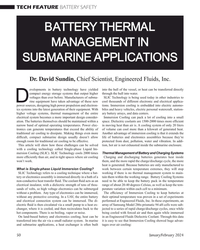 )
January 2024 - Marine Technology Reporter page: 50
)
January 2024 - Marine Technology Reporter page: 50TECH FEATURE BATTERY SAFETY BATTERY THERMAL MANAGEMENT IN SUBMARINE APPLICATIONS Dr. David Sundin, Chief Scientist, Engineered Fluids, Inc. evelopments in battery technology have yielded into the hull of the vessel, or heat can be transferred directly compact energy storage systems that output higher
-
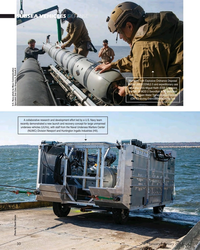 )
January 2024 - Marine Technology Reporter page: 30
)
January 2024 - Marine Technology Reporter page: 30undersea vehicles (UUVs), with staff from the Naval Undersea Warfare Center (NUWC) Division Newport and Huntington Ingalls Industries (HII). Photo By David Stoehr Specialist 2nd Class Gregory A. Pickett II 30 January/February 2024 MTR #1 (18-33).indd 30 1/31/2024 8:46:34 A
-
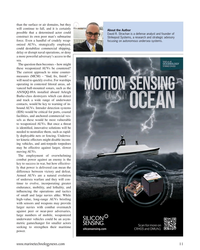 )
January 2024 - Marine Technology Reporter page: 11
)
January 2024 - Marine Technology Reporter page: 11than the surface or air domains, but they will continue to fall, and it is certainly About the Author possible that a determined actor could David R. Strachan is a defense analyst and founder of construct its own poor man’s submarine Strikepod Systems, a research and strategic advisory force. Even a
-
 )
January 2024 - Marine Technology Reporter page: 8
)
January 2024 - Marine Technology Reporter page: 8INSIGHTS SUBSEA DEFENSE SILENT, MOBILE, DEADLY: THE RISE OF COMBAT AUVS Copyright Jesper/AdobeStock By David Strachan, Senior Analyst, Strikepod Systems rone warfare has come into its own. The war in targeted by warship point defense systems and helicopter gun- Ukraine, what many analysts are calling
-
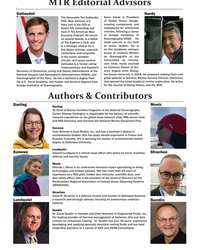 )
January 2024 - Marine Technology Reporter page: 6
)
January 2024 - Marine Technology Reporter page: 6? cer. She is the president of the board of directors for the Northeastern Regional Association of Coastal Ocean Observing Systems (NERACOOS). Strachan David R. Strachan is a defense analyst and founder of Strikepod Systems, a research and strategic advisory focusing on autonomous undersea Lundquist Sundin syst
-
 )
January 2024 - Marine Technology Reporter page: 4
)
January 2024 - Marine Technology Reporter page: 4, essentially a small, uncrewed Celia Konowe Edward Lundquist military submarine that is designed to stay at sea for up to six months at time to complete David Strachan as many missions that can be loaded into its considerable payload bay. In fact, “The sky’s the limit in terms of payloads that can be brought
-
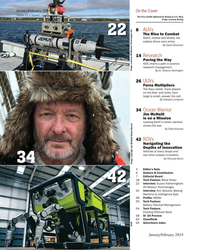 )
January 2024 - Marine Technology Reporter page: 2
)
January 2024 - Marine Technology Reporter page: 2XLUUV delivered by Boeing to U.S. Navy Image courtesy Boeing 8 AUVs 22 The Rise to Combat Silent, mobile and deadly, the subsea drone wars arrive. By David Strachan 14 Research Paving the Way NOC charts a path in science research management. By Dr. Eleanor Darlington 26 UUVs Force Multipliers
-
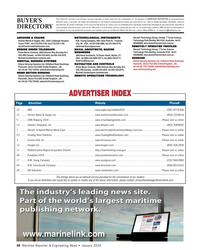 )
January 2024 - Maritime Reporter and Engineering News page: 48
)
January 2024 - Maritime Reporter and Engineering News page: 48429498089, [email protected] Texas 77087 , tel:(713) 644-1183, fax:(713) 644-1185, City, MI , USA , tel:231-946-3980, fax:231-946-4772, [email protected] [email protected] REMOTELY OPERATED VEHICLES ENGINE ORDER TELEGRAPH NAVAL ARCHITECTS, MARINE Harvest Technology Group
-
 )
November 2023 - Marine Technology Reporter page: 14
)
November 2023 - Marine Technology Reporter page: 14well as the broader opera- Timing (PNT) attacks (e.g. GPS spoo? ng), which can result tional and strategic challenges they will present. About the Author David R. Strachan is a defense analyst and founder of Strikepod Systems, a research and strategic advisory focusing on autonomous undersea systems. 14
-
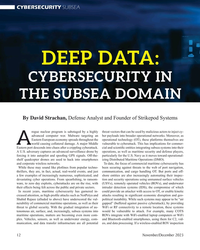 )
November 2023 - Marine Technology Reporter page: 12
)
November 2023 - Marine Technology Reporter page: 12CYBERSECURITY SUBSEA DEEP DATA: CYBERSECURITY IN THE SUBSEA DOMAIN By David Strachan, Defense Analyst and Founder of Strikepod Systems rogue nuclear program is sabotaged by a highly threat vectors that can be used by malicious actors to inject cy- advanced computer worm. Malware targeting an ber payloads
-
 )
November 2023 - Marine Technology Reporter page: 6
)
November 2023 - Marine Technology Reporter page: 6issues. He is a well as ISOs and RTOs. regular contributor to Maritime Reporter Gullick and MTR. Strachan Huw Gullick is Associate Director at NOC David R. Strachan is a defense analyst Innovations. His role involves ? nding Paradise and founder of Strikepod Systems, a real life application for
-
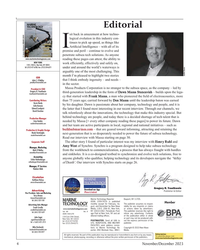 )
November 2023 - Marine Technology Reporter page: 4
)
November 2023 - Marine Technology Reporter page: 4technology and people, and it is Celia Konowe Edward Lundquist the latter that I found most interesting in our recent interview. Through our channels, we David Strachan talk relentlessly about the innovations, the technology that make this industry special. But behind technology are people, and today there
